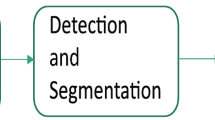Abstract
Malaria is a blood disease caused by the Plasmodium parasites transmitted through the bite of female Anopheles mosquito. The identification of the parasitized blood cells is a laborious and challenging task as it involves very complex and time consuming methods such as spotting the parasite in the blood and counting the number of the parasites. This examination can be arduous for large-scale diagnoses, resulting in poor quality. This paper presents a new Convolutional Neural Network (CNN) architecture named P-FideNet aimed at the detection of Malaria. The proposed CNN model can be used to solve image classification problems of blood cells infected or not by parasite X. This tool makes the process of analysis by the specialist faster and more accurate. Comparative tests were carried out with state-of-the-art works, and P-FideNet achieved 98.53% recall, 98.88% accuracy and 99% precision.
Access this chapter
Tax calculation will be finalised at checkout
Purchases are for personal use only
Similar content being viewed by others
References
Chimieski, B.F., Fagundes, R.D.R.: Association and classification data mining algorithms comparison over medical datasets. J. Health Inform. 5(2), 44–51 (2013)
Das, D.K., Ghosh, M., Pal, M., Maiti, A.K., Chakraborty, C.: Machine learning approach for automated screening of malaria parasite using light microscopic images. Micron 45, 97–106 (2013)
Doi, K.: Current status and future potential of computer-aided diagnosis in medical imaging. Br. J. Radiol. 78(suppl\_1), s3–s19 (2005)
Fatima, T., Farid, M.S.: Automatic detection of plasmodium parasites from microscopic blood images. J. Parasit. Dis. 44(1), 69–78 (2020). https://doi.org/10.1007/s12639-019-01163-x
He, K., Zhang, X., Ren, S., Sun, J.: Deep residual learning for image recognition. In: Proceedings of the IEEE Conference on Computer Vision and Pattern Recognition, pp. 770–778 (2016)
Huang, G., Liu, Z., Van Der Maaten, L., Weinberger, K.Q.: Densely connected convolutional networks. In: Proceedings of the IEEE Conference on Computer Vision and Pattern Recognition, pp. 4700–4708 (2017)
Iandola, F.N., Han, S., Moskewicz, M.W., Ashraf, K., Dally, W.J., Keutzer, K.: SqueezeNet: AlexNet-level accuracy with 50x fewer parameters and 0.5 MB model size. arXiv preprint arXiv:1602.07360 (2016)
Janocha, K., Czarnecki, W.M.: On loss functions for deep neural networks in classification. arXiv preprint arXiv:1702.05659 (2017)
Kashtriya, V., Doegar, A., Gupta, V., Kashtriya, P.: Identifying malaria infection in red blood cells using optimized step-increase convolutional neural network model 8, 813–818 (2019)
Liang, Z., et al.: CNN-based image analysis for malaria diagnosis. In: 2016 IEEE International Conference on Bioinformatics and Biomedicine (BIBM), pp. 493–496. IEEE (2016)
Masud, M., et al.: Leveraging deep learning techniques for malaria parasite detection using mobile application. Wirel. Commun. Mob. Comput. 2020, 5–13 (2020)
World Health Organization, et al.: World malaria report 2014. Who, Geneva. Fecha de consulta 23, 247 (2018)
Pedrini, H., Schwartz, W.R.: Análise de imagens digitais: princípios, algoritmos e aplicações. Thomson Learning (2008)
Powers, D.: Evaluation: from precision, recall and f-factor to roc, informedness, markedness & correlation. Technical report SIE-07-001. School of Informatics and Engineering, Flinders University, Adelaide, Australia (2016)
Rahman, A., et al.: Improving malaria parasite detection from red blood cell using deep convolutional neural networks. arXiv preprint arXiv:1907.10418 (2019)
Rajaraman, S., et al.: Pre-trained convolutional neural networks as feature extractors toward improved malaria parasite detection in thin blood smear images. PeerJ 6, e4568 (2018)
Rajaraman, S., Jaeger, S., Antani, S.K.: Performance evaluation of deep neural ensembles toward malaria parasite detection in thin-blood smear images. PeerJ 7, e6977 (2019)
Simonyan, K., Zisserman, A.: Very deep convolutional networks for large-scale image recognition. arXiv preprint arXiv:1409.1556 (2014)
Warhurst, D., Williams, J.: ACP broadsheet no 148. July 1996. Laboratory diagnosis of malaria. J. Clin. Pathol. 49(7), 533 (1996)
WHO: World malaria report 2019. World Health Organization (2020)
Author information
Authors and Affiliations
Corresponding author
Editor information
Editors and Affiliations
Rights and permissions
Copyright information
© 2020 Springer Nature Switzerland AG
About this paper
Cite this paper
Cruz, D. et al. (2020). P-FideNet: Plasmodium Falciparum Identification Neural Network. In: Bebis, G., et al. Advances in Visual Computing. ISVC 2020. Lecture Notes in Computer Science(), vol 12509. Springer, Cham. https://doi.org/10.1007/978-3-030-64556-4_29
Download citation
DOI: https://doi.org/10.1007/978-3-030-64556-4_29
Published:
Publisher Name: Springer, Cham
Print ISBN: 978-3-030-64555-7
Online ISBN: 978-3-030-64556-4
eBook Packages: Computer ScienceComputer Science (R0)




